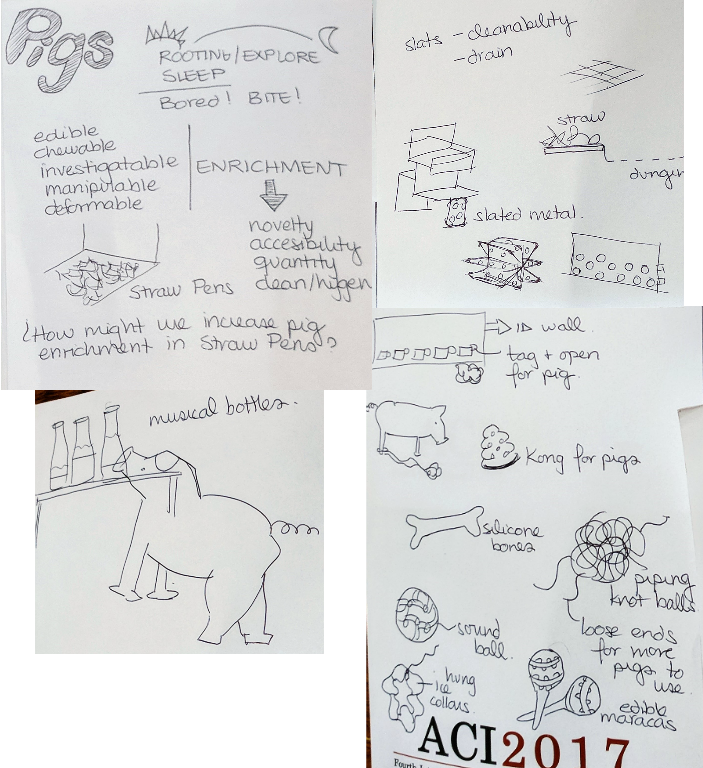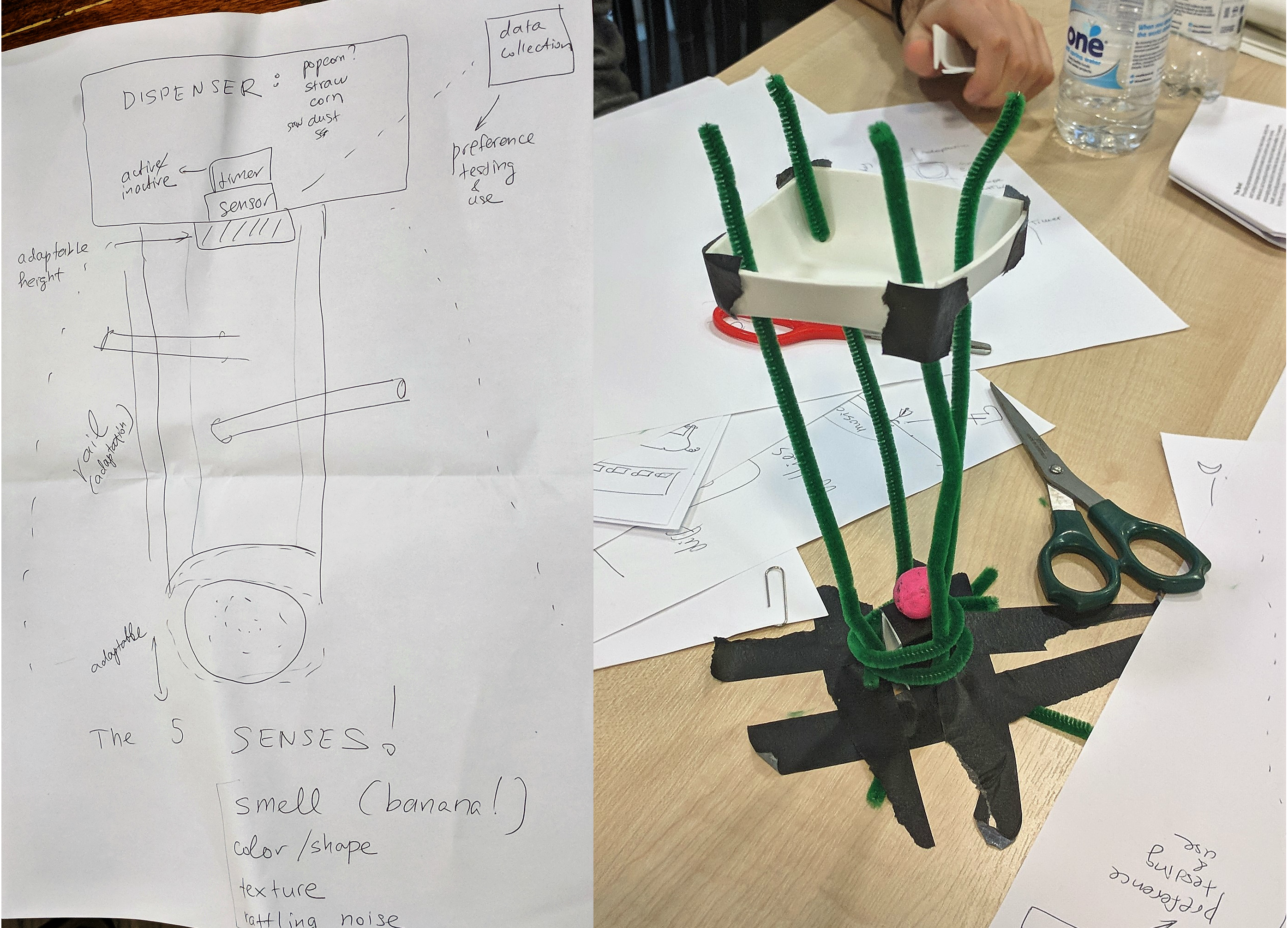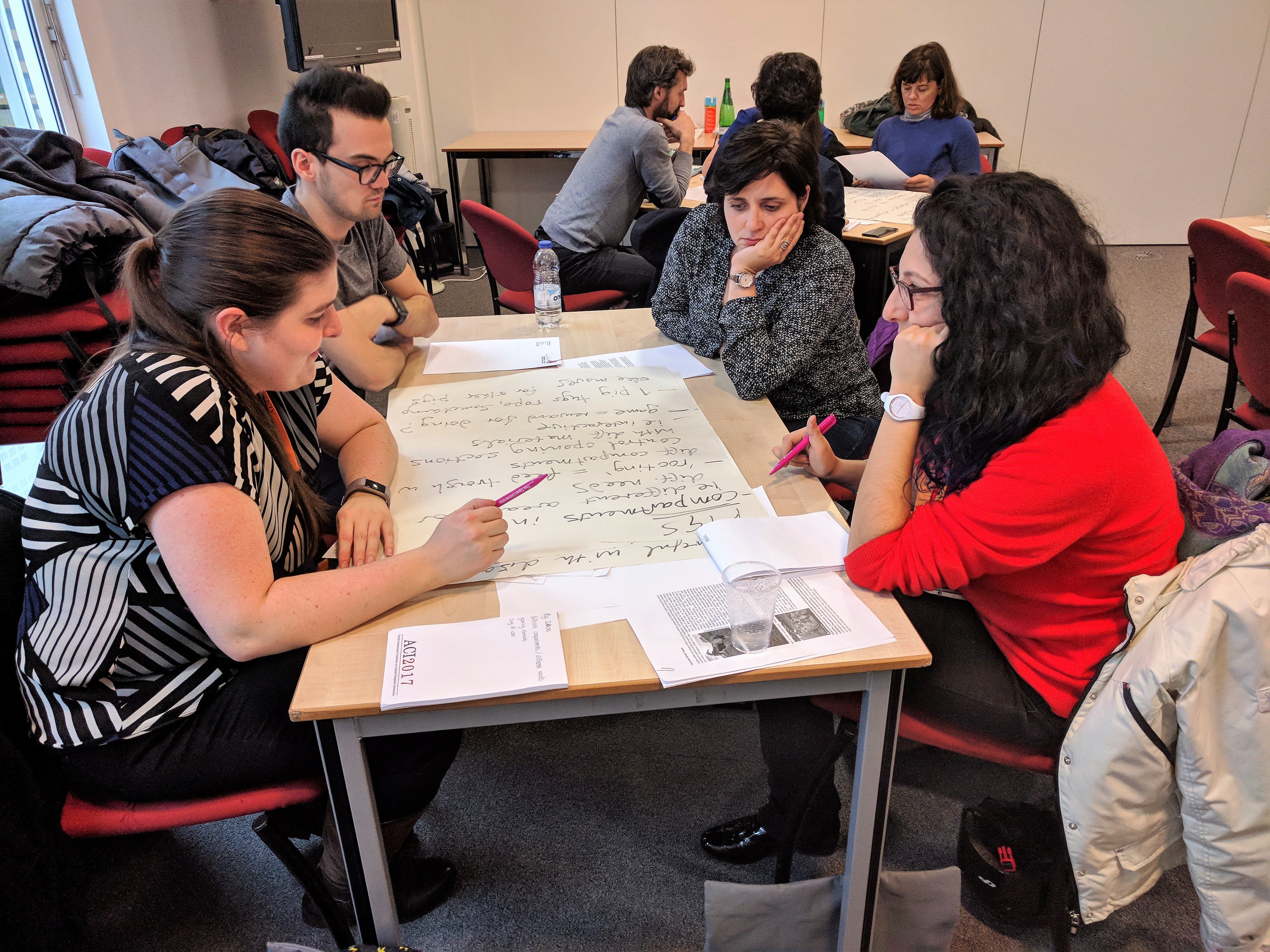PIGS
Presentations
Environmental enrichment for pigs from Fiona French on Vimeo.
Presented by Sconaid Wastie, Eleonora Nannoni, Anna Zamansky and Francisko Carpio.
Brainstorming
Things pigs might like to do - puzzles, tossing/lifting, chew ropes, play with blocks, choose sounds, receive food/straw rewards, chew branches, collaboration. Straw is preferred enrichment, but may not be available in large production plants with slatted floor (blocks the drains).

- CHOICE AND PREFERENCE TESTING - pull/tug or button to advance conveyor of wellies, balls etc
- ROOTING - Feed trough with different compartments; Flaps over feed trough with different zones - can push snout in to forage and root amongst peat/straw etc. Could control opening sections with different materials - interactive
- ISSUES RAISED - Practicalities of small v big group; Technology helps with labour cost, collecting data and implementation of system; Careful with disease transmission
- IDEAL = Compartments in pen = different areas for different needs; Have “feed”, “wellness”, “gaming” zones and allow pigs to cycle through them
- CHEAP solution = Rope nest on wall with edible blocks, branches and/or toys inside; Salt ball on rope; Food offered inside ice block, slowly melts away
- Autofeed for tagged pigs v. GAMES (cognitive enrichment)- Puzzle to solve = food rewards. Eg. metal platform with light and buttons to press (Simon Says), or rope to pull, lever to change position; or pig tugs rope and something moves for a different pig
- ACOUSTIC - Acoustic reward = sounds like food not wolf howl; Noisemaker = rope knotted balls with different sounds; Use item to make sounds; Touchscreen for piglets? Cost


Brief [1] - Sconaid Wastie, RSPCA Farm Animals
Pigs are naturally curious and intelligent animals and previous studies have likened their level of intelligence to dogs. Pigs have very good hearing and sense of smell and rely on these senses more than vision. Wild pigs will spend a large amount of their day exploring and rooting around their environment. These inherent traits can mean that they often become bored in many farmed environments. EU law requires that all pigs have access to material to enable proper investigation and manipulation activities (enrichment), however the suitability of the enrichment provided varies in practice. When suitable enrichment items are not available, then pigs can become bored stressed and/or frustrated. This can result in abnormal behaviours such as tail biting.
The best enrichment materials for pigs will fulfill the following criteria; edible, chewable, investigable, manipulable/deformable. The fewer of these criteria an enrichment item meets then the less suitable it will be. In addition to the above factors enrichment also needs to maintain novelty, be accessible to as many pigs as possible and/or provided in sufficient quantity and be easy to keep clean and hygienic. The number of pigs in a pen in the UK can typically range from 10 - 100+ pigs depending on the housing system.
All pigs reared to RSPCA welfare standards must be provided with bedding, most commonly straw, and additional straw may be provided as enrichment. Straw is an excellent enrichment material, however, the provision of further enrichment materials can help to further enhance welfare, for example by providing cognitive challenge. Chains, salt blocks and plastic piping are commonly used in addition to straw, but these are not optimal forms of enrichment. A source of enrichment which can be used in straw systems and fulfil as many of the above criteria (in bold) as possible, could help to further enhance pig welfare on farm.
Brief [2] Designing enrichment for commercially raised pigs - Billy Wallace, Makeway Ltd
Provision of enrichment for commercially raised pigs is not only a pre-requisite in EU Animal Welfare regulations, it is also an extremely important aspect of improving the economics of the production system by facilitating the rearing of healthy profitable pigs. The current EU regulations state that environmental enrichment must include maniputable material. This maniputable material has two functions: (a) to satisfy the rooting and investigatory behaviour of the pigs and (b) to reduce the risk of injuries from repetitive vices such as tail & ear biting. Examples of maniputable material are chopped straw, hay, wood, sawdust, mushroom compost, peat or a mixture of such. Any material considered must not affect the health of pigs.
Pigs are naturally very curious animals and will explore their environment continuously. They also can be quite destructive in terms of chewing and pulling and the challenge has been to design enrichment that can withstand the rigours of the typical behaviour of the pigs. Commercially raised pigs are typically kept in groups of 20 – 100 animals, the group typically the one age or size. Pig behaviour can be influenced by a number of environmental factors such as stocking density, ventilation rates, feed & water availability, lighting and flooring. We must assume in this brief that all of these factors are optimum for the group of pigs. The second most important challenge is that in modern commercial large scale farms the numbers of groups of pigs to deal with on any one unit can be in the 100’s therefore the cost of the enrichment solutions in each group is a consideration. Not only has the initial cost to be considered but also the replacement cost as the wear and tear on such enrichment items is significant, including the labour requirement of same.
Another important consideration is that the environment in the rooms with the pigs can be quite aggressive to unprotected materials. Generally any mounting materials need to be made from stainless steel or plastic or hot dip galvanize. Any electronic items in the rooms need to be well protected and be minimum IP66 rated.
Typical solutions that the industry currently have incorporated the enrichment requirement with the maniputable material, typical solutions include chewable plastic objects of various shapes and sizes in combination with other items such as chains, wood, balls etc. that provide a distraction and reduce the wear on tear on the “chewable” item. Examples of current solutions and typical group accommodation scenarios are shown below. Consider the presentation of the enrichment as it can affect its wear and effectiveness. Also consideration must be given to the different requirements of the different age groups as what is suitable for young pigs, less wear and tear, may not last in the older pig groups where the wear and tear is considerably more effective.
A happy healthy pig in a suitable environment means that the producers are maximising their profitability. Reducing stressors on the pig ensures less interventions are needed in terms of health and medication. While the debate will go on about the pros & cons of intensive versus extensive production systems, (outside the scope of this brief) most consumers main concern is that the food they are getting is produced in a system that promotes the health and well-being of the animals.
Brief [3] The case of Italian heavy pigs - Eleonora Nannoni
Italian heavy pigs are intended for the production of PDO (Protected Designation of Origin) dry-cured hams, such as Parma ham. The product specifications require pigs at least 9 months old and weighing approximately 160 kg at slaughter, and reared under specific feeding strategies, involving a feed restriction in the late phase.
Heavy pigs are mostly raised in intensive farms, inside collective pens on slatted concrete floors. On this kind of floor, manupilable materials such as chopped straw, hay, wood, sawdust, mushroom compost and peat can not be used, because it would interfere with manure removal systems.
Due to the longer production cycle if compared to most other countries (in which pigs are slaughtered at approximately 5-6 months of age and 100 kg of body weight), Italian heavy pigs may be more exposed to chronic stressors such as frustration due to hunger, barren environments, low space allowance, slatted floors and competition for resources. The peculiar welfare risks in this production chain make even more difficult designing appropriate enrichments for this category of pigs.
A body of research addressed the possible design of point-source enrichment-objects, and the effects of such devices on pigs’ behaviour and welfare. For example, dispensers containing compressed straw blocks, straw inside a metal rack, suspended ropes and loose wood blocks were tested. However, in many cases habituation quickly occurred, urging a reflection on could be an effective enrichment tool, capable to attract and sustain the pigs’ interest, stimulating their cognitive abilities and limiting the development of harmful behaviours (such as tail biting) due to boredom and frustration.
According to our behavioural observations, as pigs grow up, they tend to sleep for most of the time and to interact less with the enrichments. Within this framework, identifying the actual exploratory need of heavy pigs and monitoring enrichment use is even more challenging, because their relatively calm behaviour if compared with lighter pigs does not necessarily mean poor welfare or apathy due to the frustration of their basic needs.
